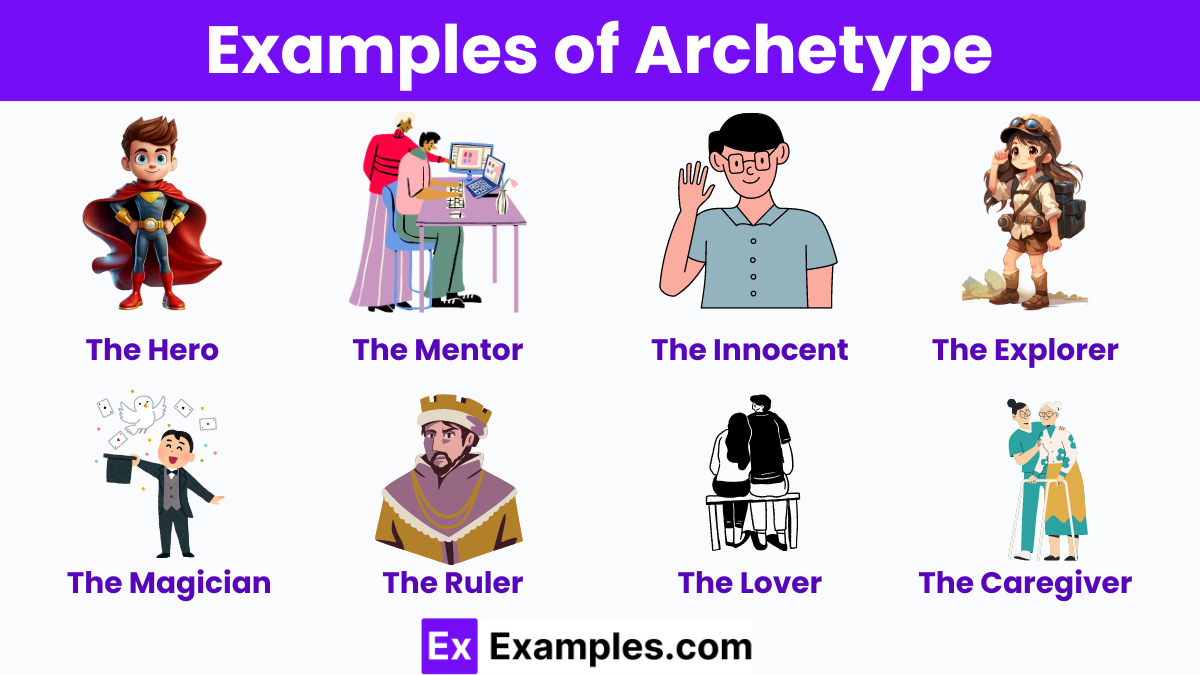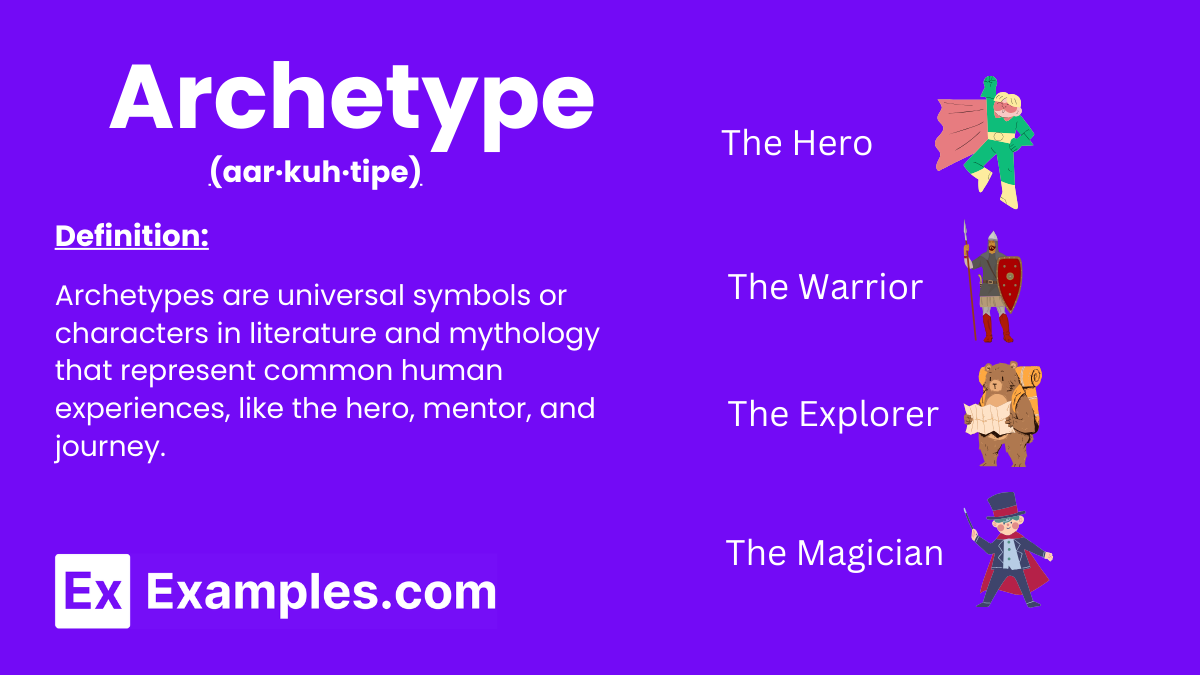Archetype
An archetype is a common character, symbol, or situation that appears repeatedly in stories and literature across cultures and time periods. Literary devices like archetypes help writers create meaningful and relatable narratives by tapping into universal experiences and emotions. For example, the hero who saves the day or the wise old mentor who guides the protagonist are archetypes that you might recognize from many of your favorite books and movies. Using these familiar elements, authors connect deeply with their audience, evoking a sense of familiarity and shared understanding.
What are Archetypes
Examples of Archetype

- The Hero: Luke Skywalker in Star Wars epitomizes the hero archetype as he embarks on a journey to save the galaxy.
- The Mentor: Gandalf serves as a powerful mentor in The Lord of the Rings, guiding Frodo through his perilous quest.
- The Mother Figure: In Harry Potter, Molly Weasley represents the nurturing mother figure, providing comfort and support to Harry.
- The Innocent: Snow White’s character is the perfect example of the innocent archetype with her purity and naivety.
- The Villain: Voldemort in Harry Potter embodies the archetype of the villain, presenting a dark force opposing the hero.
- The Scapegoat: Simon in Lord of the Flies is used as a scapegoat. He blamed for the group’s troubles due to his physical and social differences.
- The Trickster: Loki from Norse mythology often plays the trickster, causing trouble for gods and humans alike.
- The Outcast: Hester Prynne in The Scarlet Letter represents the outcast, shunned by her society for her sins.
- The Explorer: Indiana Jones, always seeking new adventures, fits the explorer archetype perfectly.
- The Rebel: Katniss Everdeen from The Hunger Games acts as the rebel, challenging oppressive authority.
- The Lover: Romeo, from Shakespeare’s Romeo and Juliet. It is an archetype of the lover, driven by the powerful force of his emotions.
- The Magician: Prospero in The Tempest uses his magical powers to orchestrate events on the island, embodying the magician archetype.
- The Ruler: King Arthur, ruling with fairness and wisdom, is a classic example of the ruler archetype.
- The Caregiver: Samwise Gamgee in The Lord of the Rings portrays the caregiver, devotedly aiding Frodo in his mission.
- The Everyman: Arthur Dent in The Hitchhiker’s Guide to the Galaxy exemplifies the everyman archetype, reacting to extraordinary events with common decency and confusion.
- The Jester: The Fool in Shakespeare’s King Lear uses wit and humor to convey truths, embodying the jester archetype.
- The Sage: Dumbledore from Harry Potter is the sage, providing wisdom to guide the young hero.
- The Warrior: Achilles in The Iliad represents the warrior archetype, driven by the glory of battle and his own prowess.
- The Orphan: Cinderella’s story begins with her as an orphan, striving to find her place and manage her grief.
- The Damsel in Distress: A character who needs to be rescued, often by the hero. Example: Princess Peach in the “Super Mario” video games.
- The Shadow: A character representing the darker, unconscious aspects of the protagonist. Example: Mr. Hyde in Robert Louis Stevenson’s “Dr. Jekyll and Mr. Hyde.”
- The Herald: A character who brings news of change or adventure, prompting the hero to act. Example: Hagrid in “Harry Potter and the Sorcerer’s Stone.”
- The Shapeshifter: A character whose loyalty or intentions are unclear, often creating suspense. Example: Severus Snape in the “Harry Potter” series.
- The Threshold Guardian: A character or force that tests the hero before they face greater challenges. Example: The Sphinx in Greek mythology.
- The Ally: A character who assists the hero on their journey. Example: Samwise Gamgee in “The Lord of the Rings.”
- The Child: A character symbolizing innocence, potential, or new beginnings. Example: Scout Finch in “To Kill a Mockingbird.”
- The Creature of Nightmare: A character that embodies fear and horror, often threatening the hero. Example: Grendel in “Beowulf.”
- The Wise Old Man/Woman: A character who imparts wisdom and advice to the hero. Example: The Oracle in “The Matrix.”
- The Destroyer: A character who brings about destruction and chaos, often without clear motives. Example: The Joker in “Batman.”
- The Creator: A character who brings something new into existence, often driven by imagination and innovation. Example: Victor Frankenstein in Mary Shelley’s “Frankenstein.”
Platonic Archetypes
Platonic archetypes refer to the ideal forms or concepts that exist in the realm of ideas, according to the philosophy of Plato. He proposed that these perfect forms are the truest reality, and everything in the physical world is merely a reflection of these ideals. For example, a perfect circle in the world of forms is the archetype of all circles we see or draw in our physical existence. Similarly, concepts like beauty or goodness have their purest forms as archetypes in this ideal realm. Plato’s theory suggests that by studying and understanding these archetypes, we can approach the true essence of things, transcending the imperfections of the material world. This idea profoundly influences not only philosophy but also art, literature, and psychology, where the pursuit of ideal forms often guides creative and moral reasoning.
Jungian Archetypes
Jungian archetypes, developed by the psychologist Carl Jung, are innate, universal symbols and themes that reside in the collective unconscious of all humans. According to Jung, these archetypes manifest in our dreams, myths, and stories, reflecting core aspects of the human experience. Some key Jungian archetypes include the Self, representing the unified unconscious and conscious mind; the Shadow, embodying our hidden and repressed traits; the Anima and Animus, symbolizing the feminine and masculine aspects within us; and the Persona, which is the mask we present to the world. Jung believed that understanding and integrating these archetypes into our conscious awareness could lead to psychological growth and balance. This concept has been influential in various fields, including psychology, literature, and even film studies, as it offers a deep framework for understanding character development and human behavior.
How to Use Architype in a Sentence
An archetype can be used in a sentence to describe a universal symbol, character, or theme that appears across various stories and cultures.
In literature
“Harry Potter is often seen as an archetype of the hero’s journey, facing numerous challenges and ultimately growing stronger.”
In psychology
“Carl Jung’s theory of archetypes suggests that these universal symbols exist in our collective unconscious.”
In discussions
“The use of archetypes can make a story more relatable and compelling by tapping into familiar patterns.”
In storytelling
“The mentor archetype, like Gandalf, provides the hero with wisdom and guidance.”
In analysis
“The trickster archetype, embodied by characters like Loki, adds complexity and unpredictability to a narrative.”
In education
“Teaching students about archetypes helps them understand the underlying structures of stories and characters.”
Tips for Using Architype
- Focus on the action: Start with the character or entity and describe what they do or represent.
- Highlight the archetype’s role: Clearly state how the archetype influences the story or character.
- Use strong verbs: Choose verbs that clearly show the action being taken.
- Be specific: Mention the specific actions or characteristics of the archetype in the context of the story.
- Show impact: Demonstrate how the archetype affects other characters or the plot.
What is considered an archetype?
An archetype is a universally recognized symbol, theme, or character that recurs across cultures and literature.
What is the Rarest Female Archetype?
The Rarest female archetype is often considered the “Huntress,” symbolizing independence and skillfulness.
Are There Archetypes in Real Life?
Yes, archetypes exist in real life as universal patterns of behavior that resonate with collective human experiences.
What is a Modern Archetype?
A modern archetype refers to contemporary symbols or characters like the “Rebel” or “Superhero” that reflect current cultural norms.
How Do Archetypes Affect Personality?
Archetypes shape personality by influencing our motivations, actions, and how we relate to others and ourselves on a subconscious level.
What are Archetypes in Spirituality?
Spirituality views archetypes as transcendent ideals or beings that represent various aspects of the divine or human experience.
Are Archetypes Positive or Negative?
Archetypes can be both positive and negative, representing the dual aspects of human nature and experiences in stories and psychology.
What is the Most Powerful Archetype?
The “Hero” is often viewed as the most powerful archetype, embodying courage, sacrifice, and the journey towards self-discovery.
How Do Archetypes Work?
Archetypes influence thoughts and behaviors by embodying fundamental human desires and experiences that shape our interactions and choices.
What is Archetype for Dummies?
An archetype is a basic, instinctual pattern of behavior or symbol universally recognized and embedded in humanity’s collective unconscious.



